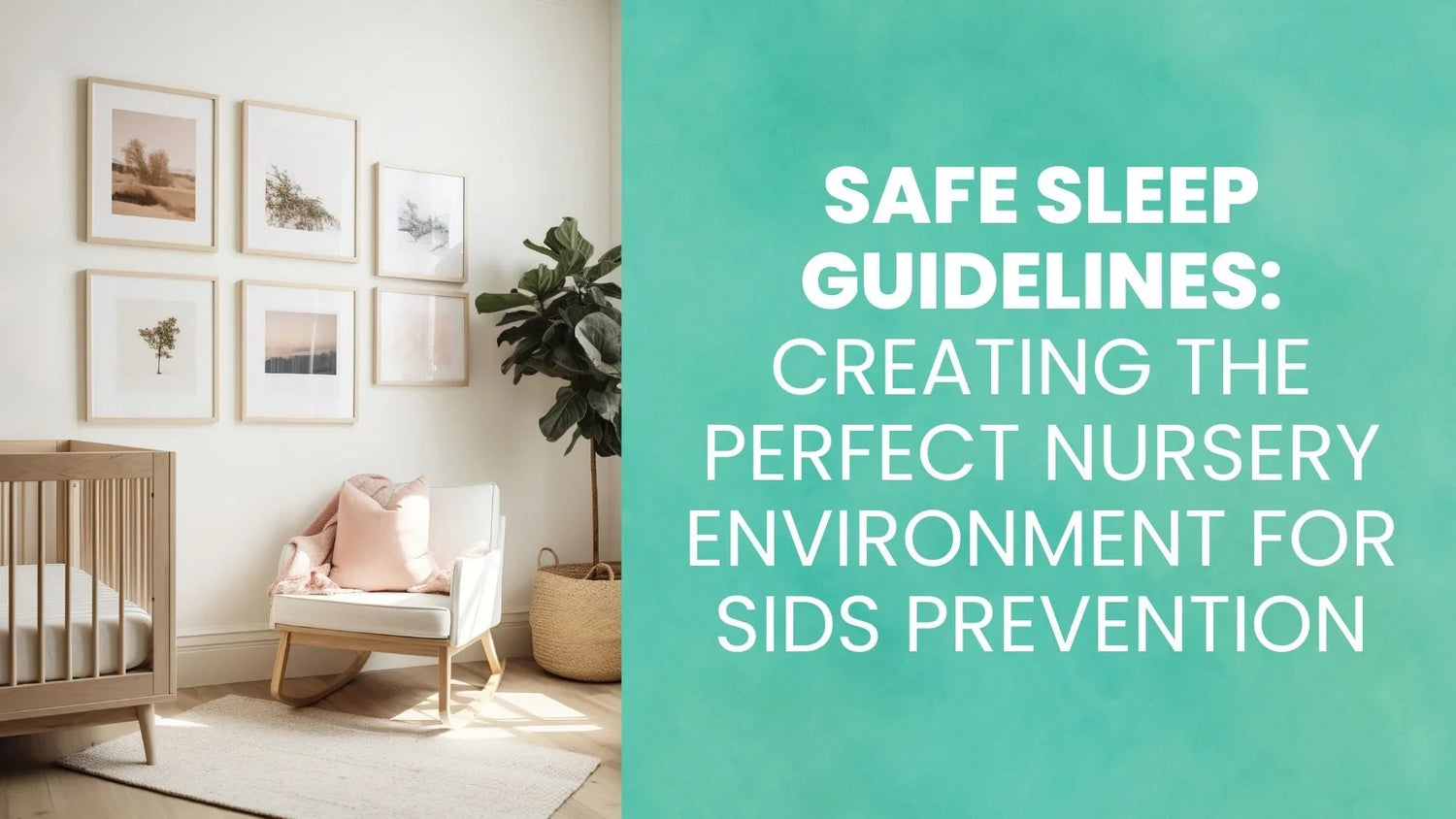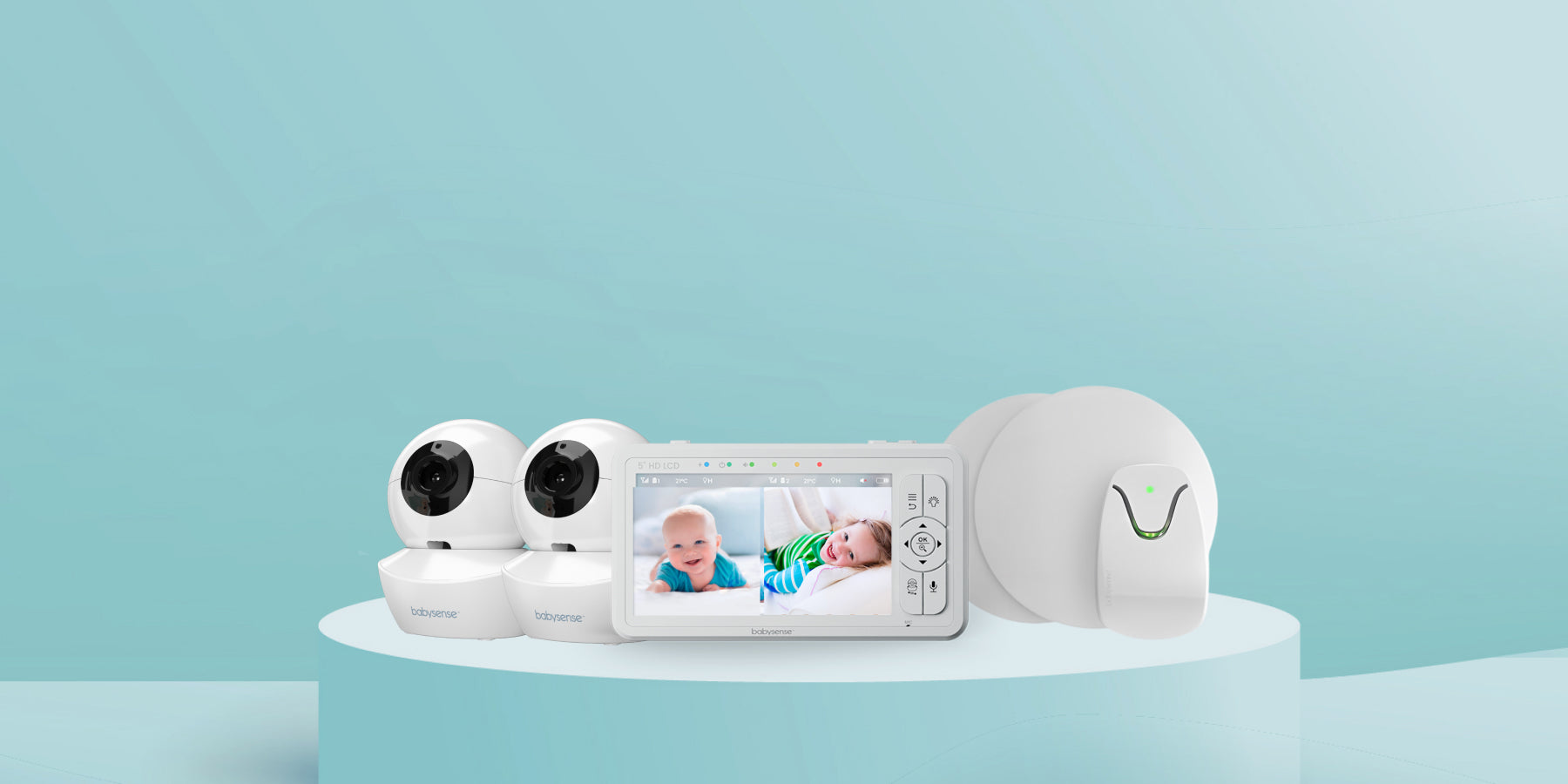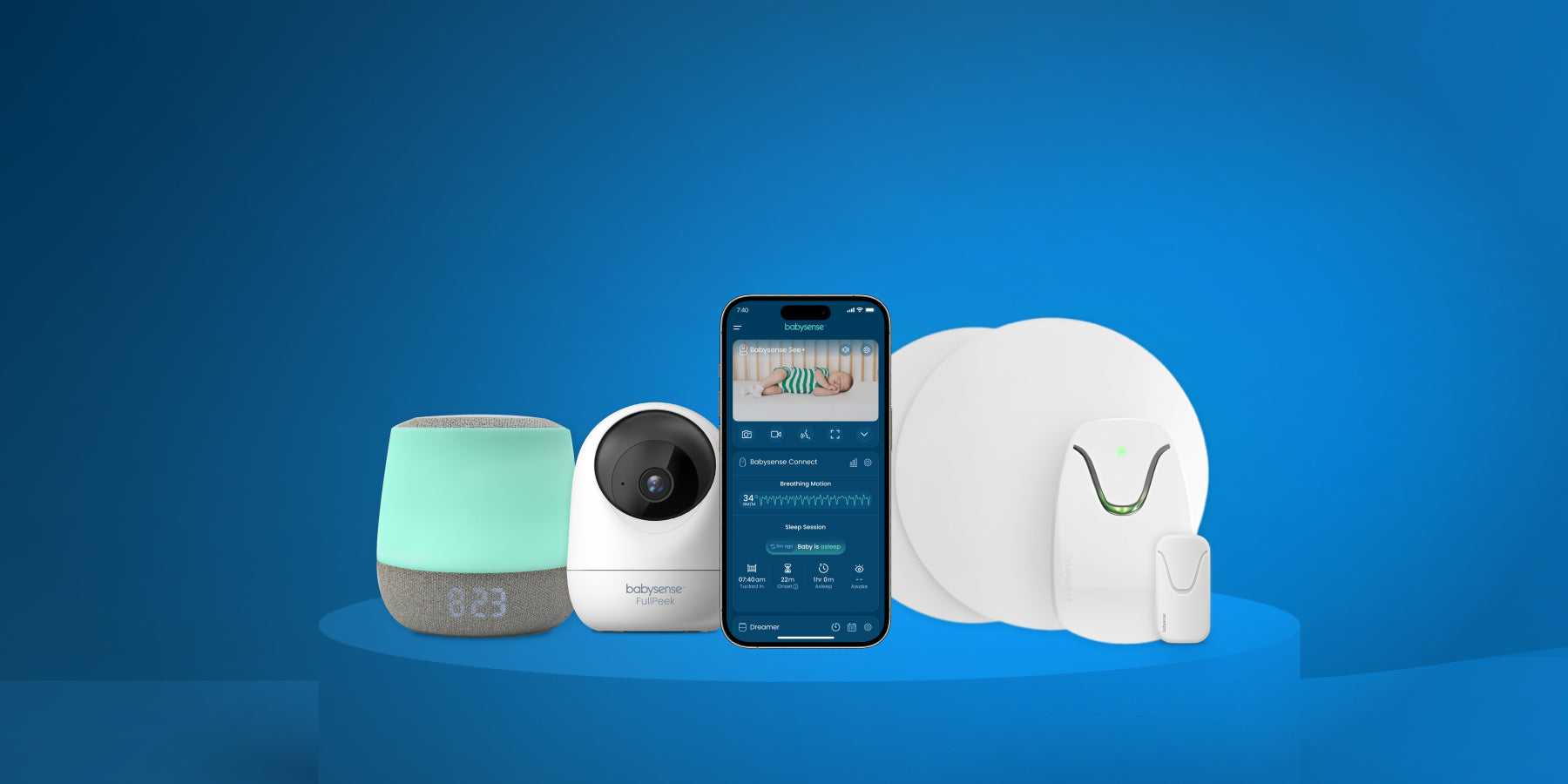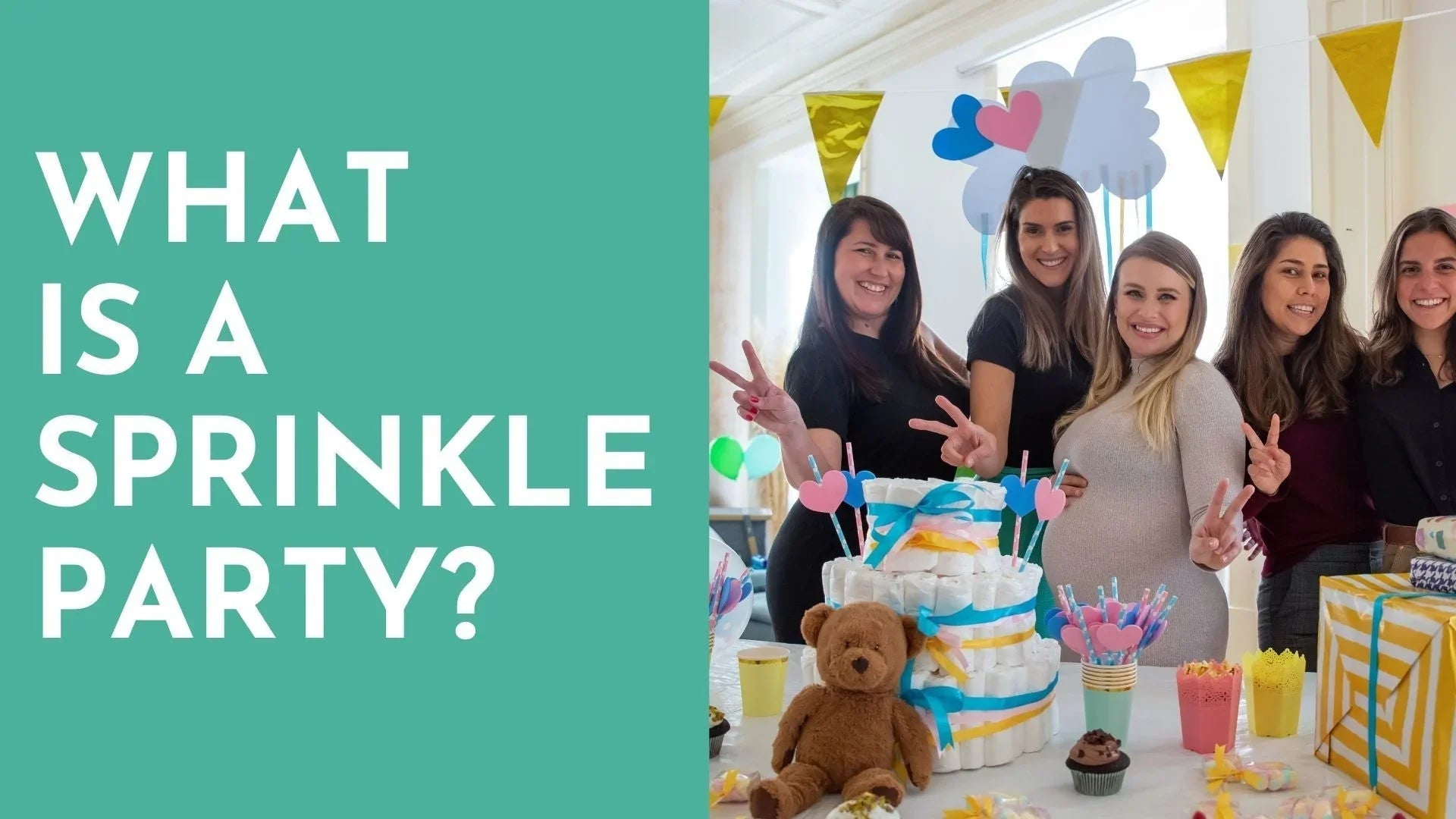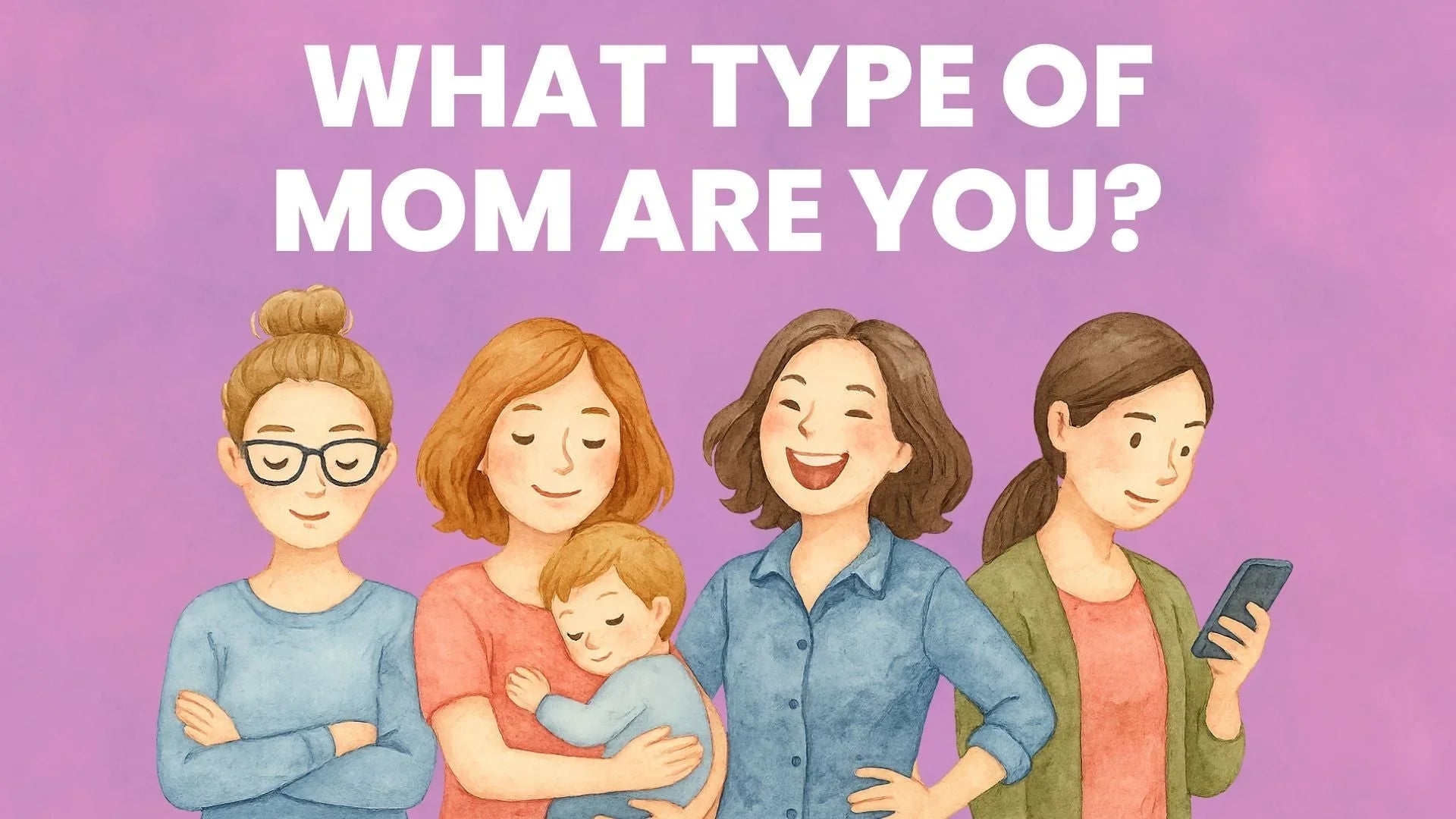Safe sleep for babies has prevented thousands of infant deaths since the 1990s, with SIDS rates dropping by 77% when evidence-based guidelines are consistently followed. Yet many parents feel overwhelmed by conflicting advice about creating the safest possible nursery environment for their baby.
Quick Answer: The safest nursery follows the 2022 AAP guidelines: back sleeping on firm surfaces, room sharing without bed sharing, maintaining 68-72°F temperature, eliminating all soft bedding, and using evidence-based SIDS prevention strategies consistently.
Following the latest medical guidelines, understanding your nursery environment, and implementing practical safety measures can significantly reduce sleep-related risks while giving you confidence as a new parent.
The American Academy of Pediatrics updated their safe sleep guidelines in 2022—the first major revision since 2016—based on analysis of 159 scientific studies. These evidence-based recommendations, combined with proper nursery safety checklist implementation and modern monitoring technology, create a comprehensive approach to safe sleep for babies.
Table of Contents
- Essential Safe Sleep Checklist
- Nursery Environment Setup
- SIDS Prevention Strategies
- Step-by-Step Setup Guide
- Common Mistakes to Avoid
Why Safe Sleep Guidelines Save Lives: Understanding SIDS Prevention
What causes SIDS? Before diving into specific nursery safety checklist items, it's essential to understand what we're protecting against. Sudden Unexpected Infant Deaths (SUID) claim approximately 3,700 American babies annually, with about 1,500 classified specifically as SIDS. These tragedies peak between 1-4 months of age, when infants' breathing control and arousal responses are still developing.
The medical community uses the "Triple Risk Model" to explain how SIDS occurs: a vulnerable infant during a critical developmental period encounters an environmental trigger. We cannot change an infant's inherent vulnerability or their developmental stage, but we have tremendous power over environmental factors. This is why safe sleep guidelines work so effectively.
The back-sleeping campaign launched in 1994 demonstrates this power. When parents consistently placed babies on their backs to sleep, SIDS deaths plummeted by more than 50% within a decade. This dramatic success story proves that following evidence-based guidelines literally saves lives—and it's why every recommendation matters.
Think of safe sleep guidelines as layers of protection, much like how we use multiple safety features in cars (seatbelts, airbags, crumple zones). No single intervention provides complete protection, but each evidence-based practice significantly reduces risk. The goal isn't perfection—it's consistent implementation of proven strategies.
The Essential Safe Sleep Checklist: Your Foundation for SIDS Prevention
What are the most important safe sleep guidelines? The 2022 AAP guidelines establish sixteen "Level A" recommendations—the highest evidence grade based on consistent, high-quality research. Think of these as your non-negotiable foundation for SIDS prevention:
Critical Sleep Position and Surface Requirements for Safe Sleep
- ✅ Place babies on their backs for every sleep—naps and nighttime—until 12 months of age
- ✅ Use only firm, flat, non-inclined surfaces with no angle greater than 10 degrees
- ✅ Room sharing without bed sharing for at least the first six months (reduces SIDS risk by up to 50%)
- ✅ Keep the crib completely bare except for a tight-fitting sheet
Proven Protective Lifestyle Factors for Baby Safety
- ✅ Breastfeed exclusively for approximately six months (provides 60% risk reduction when continued 4-6 months)
- ✅ Offer pacifiers at sleep time after breastfeeding is established (61% risk reduction)
- ✅ Eliminate all smoke exposure during pregnancy and after birth
- ✅ Avoid alcohol, marijuana, and illicit drugs during pregnancy and after birth
- ✅ Follow regular prenatal care and complete vaccination schedules
Essential Environmental Safety Measures
- ✅ Prevent overheating by dressing baby in only one layer more than adult comfort
- ✅ Never cover the baby's head during sleep
- ✅ Provide supervised tummy time for 15-30 minutes daily by 7 weeks of age
Understanding these guidelines as interconnected rather than isolated rules helps explain why consistency matters. For example, room sharing facilitates breastfeeding, which increases the likelihood of pacifier acceptance, while both practices independently reduce SIDS risk. This interconnected protection is why following all guidelines together provides much greater safety than picking and choosing.
Creating the Optimal Nursery Environment: Temperature, Air Quality, and Safety
What's the safest nursery temperature for babies? Your nursery's physical environment plays a crucial role in safe sleep for babies, yet many parents focus only on furniture without considering the broader environmental factors that affect infant safety and sleep quality.
Optimal Temperature Control for Baby Safety
How warm should a baby's room be? Maintaining proper temperature requires more precision than many parents realize. The optimal range of 68-72°F (20-22°C) isn't arbitrary—overheating increases SIDS risk, while temperatures that are too cool can disrupt sleep quality. Position your crib away from heating vents, air conditioning units, and windows to avoid temperature fluctuations that could affect your baby's body temperature regulation.
Use a room thermometer positioned at crib level rather than relying on whole-house thermostats, since temperature can vary significantly within a room. During seasonal transitions, monitor more frequently as your heating and cooling systems adjust. Dress your baby in sleep sacks or wearable blankets rather than loose bedding, adjusting thickness based on room temperature.
Nursery Air Quality: Critical for Baby's Respiratory Health
How does air quality affect baby sleep safety? Indoor air quality profoundly affects infant respiratory health, yet it's often overlooked in nursery safety checklists. Babies breathe faster than adults and are more susceptible to airborne irritants, making clean air essential for safe sleep environments.
What humidity level is best for babies? Humidity levels between 40-60% support healthy respiratory function while preventing mold growth that could trigger breathing difficulties. Use a hygrometer to monitor levels, and consider a cool-mist humidifier during dry seasons or in heated homes. However, clean humidifiers weekly to prevent bacterial growth.
Ventilation matters more than many parents realize. Open windows daily when outdoor air quality is good, ensure your HVAC system has clean filters, and consider air purifiers with HEPA filtration for homes in areas with poor outdoor air quality. Avoid chemical air fresheners, scented candles, or cleaning products with volatile organic compounds (VOCs) in the nursery.
Lighting for optimal sleep development
Light exposure affects infant circadian rhythm development and sleep quality. Dark environments promote better sleep for babies just as they do for adults. Use blackout curtains or shades to create consistent darkness for both naps and nighttime sleep.
If you need lighting for nighttime feeding and diaper changes, use the dimmest possible red-colored light, which disrupts melatonin production less than white or blue light. Position any night lights away from the baby's direct line of sight and consider timer-controlled options that automatically dim after brief use.
Advanced nursery setup: Furniture placement and product safety
Creating a truly safe nursery requires understanding how furniture placement, product selection, and room layout work together to minimize risks while maximizing functionality for exhausted parents navigating in darkness.
Crib placement and room layout strategy
Your crib's position affects both safety and practicality. Place it against a solid wall rather than floating in the room center, but ensure accessibility from both sides for easier nighttime care. Position the crib at least three feet from windows to avoid blind cords, drafts, and direct sunlight that could overheat your baby.
Keep the crib away from heating and cooling vents, which create temperature fluctuations and air currents that can affect sleep quality. Consider sight lines from your bed if room sharing—you should be able to easily see and reach your baby without obstacles, but the crib shouldn't be so close that you risk rolling against it.
CPSC compliance and product selection
Understanding current Consumer Product Safety Commission standards helps you make informed decisions about nursery products. All cribs manufactured after June 2011 must meet federal safety standards, including fixed sides (no drop-sides), slat spacing no wider than 2⅜ inches, and stronger hardware with anti-loosening devices.
The 2022 mattress safety standards require firm surfaces that spring back quickly when pressure is applied, with proper fit leaving no gaps larger than two fingers' width between mattress and crib sides. Look for certifications like GREENGUARD Gold, which indicates low chemical emissions, and avoid memory foam or adjustable-firmness mattresses that are too soft for infant sleep.
Recent recalls highlight ongoing product safety concerns. Inclined sleepers like Rock 'n Play units have been recalled due to suffocation risks, while various weighted sleep products have been removed from the market. Register all products for recall notifications and regularly check the CPSC website for updates.
Environmental hazard prevention
Anchor all heavy furniture to walls using anti-tip devices, regardless of whether your baby is mobile yet—planning ahead prevents accidents during rapid developmental changes. Secure electrical cords out of reach and use outlet covers throughout the nursery.
Window safety extends beyond crib placement. Install window guards or safety stops, use cordless window treatments when possible, and apply safety film if your windows could pose breakage risks. These precautions become more critical as babies develop mobility, but implementing them early creates habits and ensures you won't forget during busy periods.
Understanding SIDS prevention through scientific evidence
SIDS prevention strategies work best when parents understand the science behind recommendations rather than following rules without context. This knowledge helps you make informed decisions in situations not specifically addressed by guidelines and builds confidence in your implementation.
The protective power of breastfeeding
Research shows that breastfeeding's protective effect follows a clear dose-response pattern: longer duration provides greater protection. Babies breastfed for 2-4 months have 40% reduced SIDS risk, while those breastfed for more than six months show 64% risk reduction. Even partial breastfeeding provides protection, though exclusive breastfeeding offers slightly better outcomes.
The protection mechanisms aren't completely understood, but likely include enhanced immune function, reduced infection rates, and improved arousal responses during sleep. Importantly, breastfeeding's protective effect remains strong even when controlling for other factors, meaning the benefit isn't simply because breastfeeding families are more likely to follow other safe sleep practices.
Why pacifiers provide protection
The pacifier recommendation often confuses parents, especially those concerned about breastfeeding interference. Current research shows pacifiers reduce SIDS risk by 61% when used during sleep times, even if they fall out after the baby falls asleep. The protection appears to work through improved airway patency and enhanced autonomic nervous system responses.
You can introduce pacifiers after breastfeeding is established (typically 3-4 weeks) without significantly affecting feeding success. The protective effect occurs only during sleep, so pacifiers don't need to be used constantly—just offered when putting baby down for naps and bedtime.
Room sharing's dual benefits
Room sharing without bed sharing provides protection through two mechanisms: enhanced parental responsiveness to infant distress and prevention of more dangerous sleep arrangements. Parents sleeping in the same room respond faster to infant breathing changes or movement, potentially intervening before problems become serious.
Equally important, room sharing reduces the likelihood of bed sharing, particularly during exhausting night feedings when parents might accidentally fall asleep while nursing. Having an appropriate infant sleep surface within arm's reach makes it easier to maintain safe practices even when extremely tired.
Baby Monitors and Safe Sleep: Evidence-Based Monitoring Strategies
Do baby monitors prevent SIDS? Modern baby monitoring technology offers sophisticated surveillance capabilities, but understanding how baby monitors complement rather than replace evidence-based practices is crucial for maintaining proper perspective on infant safety.
The Medical Consensus on Baby Monitoring Technology
The American Academy of Pediatrics states clearly: "Do not use home cardiorespiratory monitors as a strategy to reduce the risk of SIDS." This recommendation isn't due to technological limitations—it reflects the absence of scientific evidence that any monitoring device can prevent SIDS or reduce sleep-related deaths.
Can baby monitors replace safe sleep practices? The FDA reinforces this position, stating they are "not aware of any scientific studies showing that a medical device prevents or reduces the risk of SIDS." Companies avoid FDA regulation by marketing monitors as wellness devices rather than medical devices, but this doesn't change their inability to prevent the events parents most fear.
This evidence-based perspective doesn't mean monitors are worthless—it means they serve different purposes than SIDS prevention. Understanding these limitations helps parents use monitoring technology appropriately while maintaining focus on proven safety practices.
Proper Baby Monitor Use for Safe Sleep
How should parents use baby monitors safely? Baby monitors excel as surveillance and communication tools. They help parents respond to infant needs across distance, monitor environmental conditions like temperature, and provide peace of mind during the adjustment to parenthood. These benefits are valuable when monitors complement rather than replace proper sleep practices.
What baby monitors actually detect: Movement monitors can detect when babies stop moving, but they cannot distinguish between normal periodic breathing (common in infants) and dangerous breathing interruptions. Pulse oximetry monitors often provide inaccurate readings in infant-sized devices and may create false alarms that increase rather than decrease parental anxiety.
The most beneficial use of monitors involves enhancing supervision while maintaining all evidence-based safe sleep practices. Think of monitors as tools that help you respond to your baby's needs, not as devices that make unsafe practices acceptable or replace the fundamental requirement for safe sleep environments.
When monitors become counterproductive
Monitors create false security when parents relax safe sleep practices believing technology provides protection. Some families use monitors to justify unsafe sleep positions, bed sharing, or inappropriate sleep surfaces—exactly the opposite of their intended purpose.
Watch for signs that monitoring technology is increasing rather than decreasing anxiety: obsessive checking of readings, inability to sleep without constantly monitoring data, or panic responses to normal variations in infant breathing patterns. These responses suggest monitors are creating problems rather than providing solutions.
Healthy families typically transition away from intensive monitoring as parenting confidence develops and infant risk naturally decreases after the first few months. Planning for this transition from the beginning helps prevent unhealthy dependence on technology for normal parenting tasks.
Complete Nursery Safety Checklist: Step-by-Step Setup Guide
How do I set up the safest possible nursery? Creating a safe nursery environment works best when approached systematically, building from basic safety requirements to comfort and convenience features. This step-by-step approach ensures you address critical safety elements before getting distracted by aesthetic considerations.
Phase 1: Essential Safety Foundation for Safe Sleep
What's the first step in nursery setup? Start with the sleep surface itself. Choose a CPSC-approved crib, bassinet, or play yard manufactured after 2011, and verify it meets current safety standards by checking for proper certification labeling. Select a firm mattress specifically designed for your chosen sleep surface, ensuring it fits snugly with no gaps.
Where should I place the crib for maximum safety? Install the crib in its final position away from windows, cords, and heating/cooling sources before adding any other furniture. This positioning affects room traffic flow and helps you plan the placement of other essential items like changing areas and feeding chairs.
Remove all soft objects, pillows, blankets, bumpers, and toys from the sleep area. Install only a tight-fitting sheet designed specifically for your mattress size. This "bare crib" approach eliminates suffocation risks while providing the safest possible sleep environment.
Phase 2: Environmental controls and monitoring
Install room temperature monitoring at crib level and set up humidity control systems if needed. Test your room-darkening window treatments and adjust them to achieve the darkness level you want for sleep times. Consider how you'll maintain these environmental conditions throughout seasonal changes.
Set up any monitoring equipment you plan to use, but test it thoroughly and establish realistic expectations for its capabilities. Position cameras or audio monitors to avoid cords near the sleep area while providing the visibility you want.
Plan your nighttime routine logistics: how will you move safely in darkness, where will feeding supplies be positioned, and what lighting will you use for necessary tasks without disrupting sleep? These practical considerations affect both safety and your likelihood of consistently following guidelines when exhausted.
Phase 3: Caregiver preparation and backup plans
Create written guidelines for all caregivers who will be responsible for putting your baby to sleep. Include specific instructions for your setup, emergency procedures, and important safety reminders. This documentation becomes especially valuable when you're sleep-deprived or when others are helping with childcare.
Prepare backup safe sleep options for different areas of your home where your baby might need to nap. A portable play yard or second bassinet eliminates the temptation to use inappropriate sleep surfaces when you're away from the primary nursery.
Plan how you'll handle common challenges like infant illness, extreme weather affecting room temperature, or equipment failures. Having predetermined solutions helps you maintain safe practices under stressful circumstances when good decision-making becomes more difficult.
Most Common Safe Sleep Mistakes Parents Make (And How to Avoid Them)
What are the biggest safe sleep mistakes? Understanding why parents make unsafe sleep choices helps you recognize and avoid these pitfalls in your own family. Many mistakes stem from understandable concerns about infant comfort, convenience, or misconceptions about safe sleep practices.
Mistake #1: The Comfort Trap - Adding Unsafe Bedding
Why do parents add blankets to cribs? Many parents add blankets, pillows, or soft toys to cribs because babies "look cold" or the bare crib seems uncomfortable. This mistake occurs because we project adult comfort preferences onto infants who have different thermoregulation needs and safety requirements.
The safe sleep solution: Babies regulate temperature differently than adults and often feel warm even when their hands and feet seem cool. Check temperature by feeling the chest or back of the neck rather than extremities. Use sleep sacks or wearable blankets to provide warmth without loose bedding risks.
Remember that a bare crib isn't uncomfortable for babies—it's optimal for their developmental needs and safety. Infants don't require pillows for head and neck support because their proportions are different from adults. Soft comfort objects become safe only after 12 months when suffocation risks significantly decrease.
The positioning mistake: Understanding inclined surfaces
Products marketed for reflux, comfort, or better sleep often create dangerous sleep angles. The 2022 AAP guidelines explicitly prohibit any sleep surface with an incline greater than 10 degrees following deaths associated with various inclined products.
Parents sometimes use car seats, swings, or bouncy seats for routine sleep because babies seem comfortable in these positions. However, sitting positions can compromise airway patency and make breathing more difficult, particularly for young infants with developing respiratory control.
If your baby has reflux concerns, consult your pediatrician about safe management strategies rather than using positioning products. Medical-grade solutions exist for babies with diagnosed conditions, but routine healthy infants should always sleep on flat, firm surfaces.
The consistency challenge: Maintaining practices across all caregivers
Safe sleep guidelines work only when applied consistently for every sleep episode by every caregiver. Many families maintain perfect practices for nighttime sleep but relax standards for naps, or follow guidelines when parents are present but allow variations when grandparents or other caregivers are involved.
Develop specific strategies for ensuring consistency. Provide written instructions and demonstrations for all caregivers, including detailed explanations of why each practice matters. Create easy-reference checklists and post them in sleep areas as reminders.
Address caregiver resistance proactively by acknowledging different generational experiences while emphasizing current evidence. Many grandparents raised children during eras when prone sleeping was recommended, so they need respectful education about why practices changed rather than criticism of their parenting experiences.
Room sharing implementation: Making it work for your family
Room sharing provides significant safety benefits but can be challenging to implement effectively. Success requires balancing infant safety with parental sleep quality and practical considerations that vary by family circumstances.
Setting up effective room sharing arrangements
Position the infant sleep surface within arm's reach of your bed but not so close that you risk rolling against it or that normal adult movement disturbs the baby's sleep. The ideal distance is typically 2-3 feet—close enough for easy access but far enough to maintain separate sleep spaces.
Consider sight lines and accessibility from both sides of your bed if possible. During exhausting night feeding periods, being able to easily see and reach your baby without complicated maneuvering reduces the temptation to bring the baby into your bed for convenience.
Plan how you'll handle lighting for night feedings and diaper changes without disrupting sleep. A small, dim red light positioned near your bed often works better than trying to navigate by smartphone light or room lighting that can fully wake both you and your baby.
Managing sleep quality for the whole family
Room sharing works best when you address potential sleep disruptions proactively. White noise can help mask normal infant sleep sounds that might wake parents unnecessarily while providing consistent sound cues that support infant sleep.
Understand normal infant sleep patterns to distinguish between sounds that require response and normal sleep movements or brief fussing that doesn't need intervention. Many parents respond to every sound initially but learn to differentiate between distress and normal sleep behaviors.
Consider your family's specific needs when determining how long to room share. The AAP recommends at least six months, but some families benefit from longer arrangements while others find transitioning around 3-4 months works better for their circumstances. The key is maintaining the safety benefits while supporting healthy sleep for everyone.
Transitioning away from room sharing
When you decide to transition your baby to a separate room, maintain all other safe sleep practices while adjusting to the change. Many families use audio monitors to maintain connection without the sleep disruptions of room sharing.
Plan the transition during a period when your baby's sleep patterns are relatively stable rather than during growth spurts, developmental leaps, or illness that might disrupt sleep anyway. Gradual transitions often work better than abrupt changes for both parents and babies.
Continue following all safe sleep guidelines in the baby's new room, with particular attention to maintaining appropriate room temperature and monitoring systems if you choose to use them. The reduced proximity makes consistent environmental management even more important.
Age-specific considerations: Adapting practices as babies grow
Safe sleep guidelines remain consistent throughout the first year, but practical implementation evolves as babies develop new motor skills and sleep patterns. Understanding these developmental changes helps you adapt your approach while maintaining safety priorities.
Newborn period (0-3 months): Establishing foundations
During the highest-risk period for SIDS, maintain the most vigilant adherence to all safe sleep practices. This is when environmental triggers pose the greatest danger to vulnerable infants whose arousal and breathing control systems are still developing.
Swaddling can be helpful for newborns who startle themselves awake, but ensure it's done safely: snug around the chest but loose around hips to prevent hip dysplasia, and discontinue as soon as your baby shows any signs of attempting to roll (usually around 3-4 months).
Room sharing provides maximum benefit during this period, facilitating feeding while preventing bed sharing risks. Many parents find bassinets more convenient than full-size cribs for frequent nighttime access, but ensure any bassinet meets current safety standards.
Middle infancy (3-8 months): Adapting to development
As babies develop rolling abilities, continue placing them on their backs but allow them to remain in whatever position they assume during sleep. This transition period requires vigilance to ensure your baby can roll both ways before relaxing position monitoring.
Stop swaddling immediately when your baby shows signs of rolling attempts, even if rolling isn't fully developed yet. Transition to sleep sacks or wearable blankets that allow arm movement while providing warmth and comfort.
Lower the crib mattress as your baby gains head control and begins showing signs of eventual sitting and standing abilities. Many parents wait until babies are actually pulling themselves up, but anticipating these developments prevents dangerous falls.
Later infancy (6-12 months): Maintaining vigilance with mobile babies
Continue all safe sleep practices throughout the first year even though SIDS risk decreases after 6 months. Mobile babies face different risks including entanglement and climbing hazards that require adjusted environmental management.
Remove mobiles, hanging toys, and other objects that babies might reach from a standing position in the crib. Mobile babies can pull objects into their sleep space, potentially creating hazards that weren't present during the immobile period.
Many families transition away from room sharing during this period as infant sleep becomes more consolidated and parental confidence increases. Maintain monitoring systems that work for your family while preserving all environmental safety practices.
Creating your personalized safe sleep action plan
Implementing comprehensive safe sleep practices requires translating evidence-based guidelines into practical systems that work for your specific family circumstances. This personalized approach increases compliance while maintaining safety priorities.
Developing your family-specific protocols
Start by identifying your family's specific challenges and resources. Do you have space constraints that affect room sharing? Are there cultural considerations that require respectful integration with traditional practices? Are there multiple caregivers who need consistent training?
Create written protocols that address your specific setup, including emergency procedures, caregiver instructions, and troubleshooting guidance for common challenges. Include photos of proper setup and specific product information to prevent confusion or substitutions.
Plan for different scenarios: illness periods when monitoring might increase, travel situations requiring portable safe sleep arrangements, and developmental transitions that require environmental adjustments. Having predetermined solutions reduces decision-making stress during challenging periods.
Building sustainable routines
Successful safe sleep implementation requires integrating practices into daily routines that become automatic rather than requiring conscious decision-making each time. Focus on creating systems that work even when you're exhausted, stressed, or distracted.
Practice your safe sleep routine during calm periods so it becomes natural during stressful times. This includes nighttime navigation in darkness, quick environmental checks, and proper positioning techniques that become muscle memory.
Build accountability systems with your partner and other caregivers. Regular check-ins about how practices are working and whether anyone is struggling with compliance helps address problems before they become ingrained habits.
Staying current with safety information
Register all baby products for recall notifications and periodically check the CPSC website for safety updates. Subscribe to pediatric safety newsletters or follow reputable organizations that provide updates about infant safety research and recommendations.
Plan regular safety audits of your nursery setup, especially during periods of rapid infant development when new hazards might appear. Monthly reviews help you stay ahead of safety concerns rather than reacting to problems after they develop.
Maintain connections with your healthcare providers for guidance about adapting safe sleep practices to your baby's individual needs. Some infants require modifications due to medical conditions, and professional guidance ensures you maintain maximum safety while addressing specific health requirements.
Frequently Asked Questions About Safe Sleep and Nursery Safety
Q: What's the most important thing for baby sleep safety? A: Back sleeping on a firm, flat surface is the #1 most important safe sleep practice. This single change reduced SIDS deaths by over 50%.
Q: When can babies sleep with blankets? A: After 12 months old. Until then, use sleep sacks or wearable blankets for warmth without suffocation risk.
Q: Do baby monitors prevent SIDS? A: No. The AAP clearly states monitors do not reduce SIDS risk. They're surveillance tools, not prevention devices.
Q: What room temperature is safest for babies? A: 68-72°F (20-22°C) prevents overheating while maintaining comfort for safe sleep.
Q: How long should babies room share? A: The AAP recommends room sharing for at least 6 months, which reduces SIDS risk by up to 50%.
Key Takeaways for Safe Sleep Success
✅ Follow the 2022 AAP guidelines consistently - they're based on 159 scientific studies
✅ Back sleeping on firm surfaces is non-negotiable - this prevents thousands of deaths annually
✅ Room sharing without bed sharing provides maximum protection during vulnerable months
✅ Environmental factors matter - temperature, air quality, and proper nursery setup save lives
✅ Baby monitors supplement but don't replace evidence-based safe sleep practices
The journey of implementing safe sleep practices combines evidence-based guidelines with practical family considerations. Success comes from consistent implementation of core safety principles adapted to your family's circumstances. By understanding the science behind recommendations and maintaining focus on proven strategies, you provide your baby with the safest possible sleep environment.
Safe sleep practices represent one of the most effective interventions available for protecting infant health. The dramatic 77% reduction in sleep-related infant deaths over the past three decades proves these guidelines work when families implement them consistently. Your commitment to following evidence-based SIDS prevention strategies contributes to this ongoing success story while providing the best possible protection for your baby.
Need help choosing the right baby monitor to complement your safe sleep practices? Explore our evidence-based guide to baby breathing monitors that prioritize safety over marketing claims.

